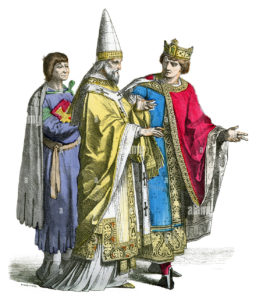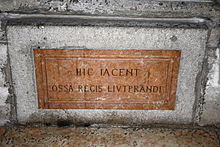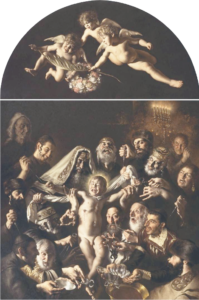– For the context of these translations click here –
A month after Charles Martel died, in December 741 Gregory III, the last Roman bishop to be confirmed by the Emperor of Byzantium, also died. His successor was Zacharias (741-752). Liutprand died at the beginning of 744, after thirty-twoyears of rule. Before the death of Charles Martel, Charles had divided the power of government between his sons Carloman, Pepin the Short and Grifo…
Already in the year of the change of government, bishoprics were created in Hesse and Thuringia (planned by Boniface since 732), and in the years 743 and 744 three great synods were held in Austrasia and Neustria, in which the total elimination of ‘heresy’ and paganism was decreed. Charlemagne and Pepin—both educated in monasteries, Charlemagne probably in the monastery of Echternach by Willibrord, and Pepin in the monastery of Saint-Denis—carried the war far and wide. Both were, as Pope Zacharias says of his ‘most illustrious sons’, ‘companions and assistants’ of Boniface. Moreover, both were ‘under the inspiration of God’ (inspiratione divina). Thus, the holy father was able to guarantee the two great butchers also ‘an abundant reward in heaven’ for ‘blessed is the man by whom God is blessed’…
Even Pepin the Younger (741-768), who generally resided in the palaces of Quierzy, Attigny, Verberie and Compiégne and to whom Pope Zacharias had already given the title of christianissimus in 747, was ‘a good Christian’ (Daniel-Rops), ‘inspired entirely by the Christian spirit’ (Büttner). In his fight against the Saxons he reached the Weser in 753, in a campaign in which Hildegard, bishop of Cologne, perished on 8 August. In 758 he entered the territory of Münster and promised the Westphalians, on whom he had inflicted a heavy defeat, loyalty, an annual tribute of 300 horses and the free movement of Christian missionaries.
In eight campaigns, conducted between 760 and 768, he subdued Aquitaine, where he had once, and still in the company of Charlemagne, set fire to the suburbs of Bourges and destroyed Loches. Now he destroyed the castles and ruined the country. He set fire to Bourbon-l’Archambault as well as Clermont, setting fire to countless villages. He was accompanied by the eldest son of Pepin, Charles (‘the Great’, Charlemagne): quite a school of life! Year after year, the Franks systematically plundered and destroyed the entire region from one end to the other. And the devastating effects of these wars could be traced back for generations…
The most momentous event of the Middle Ages
Theodor Mayer writes about the state conception of the Carolingian period: ‘It is clear what happened in the royal period of Pepin and Charles. It is the conception of kingship as an office, which does not derive from the divine descent of the royal lineage nor a military kingship, but which was instituted by God and conferred by the pope’. It was not until the Carolingian era at the latest when kingship was given a theocratic foundation and the sovereign became ‘king by the grace of God’ (rex Dei gratia), which is a formula of legitimation. ‘The revived idea of “by the grace of God” had elevated and sanctified the royal dignity since the anointing of Pepin’ (Tellenbach). And ever since the sons of Pepin, who were Carloman and Charles ‘the Great’, all medieval kings bore the title gratia Dei rex Francorum, king by the grace of God.
 The king was thus sharply separated from the people, to whose choice he originally owed his privileged position, and placed close to God. This means that, since ‘God’, properly understood and in a political vision, is only a symbol for the high clergy and their need for power, insofar as the king is separated from the people, he is linked to the priestly hierarchy and placed at their service.
The king was thus sharply separated from the people, to whose choice he originally owed his privileged position, and placed close to God. This means that, since ‘God’, properly understood and in a political vision, is only a symbol for the high clergy and their need for power, insofar as the king is separated from the people, he is linked to the priestly hierarchy and placed at their service.
The king became an organ of it, a sharer in its ministry, its creature: an ‘ecclesiastical person’. God meant de facto the Church, which gradually made its power more and more felt, which had even assigned the office of king, and the more the theocratic character of kingship was accentuated, the greater its influence.
But this collaboration with the king led to an ever more marked weakening of the people and their total powerlessness. For it was no longer the people who were to control the king, but the high clergy. The king was consciously distanced from the people and presented as majestas far above the people. The people ceased to be subjects of rights; they had only duties, absolutely subject to the sovereign, who was no longer accountable to them. In any case, this is what the models developed by the ecclesiastical hierarchy were intended to do, although they were only imposed in the following decades and centuries.






